Blue-Footed Booby: The Colorful Seabird of the Ocean
The Blue-Footed Booby, scientifically known as Sula nebouxii, is a fascinating seabird renowned for its vivid blue feet and unique mating dance. These birds, resembling the size of a goose, are a spectacle of nature, combining quirky behaviors with impressive diving skills.
Characteristics & Appearance
Weight & Length
An adult Blue-Footed Booby measures about 32 to 34 inches in length with a wingspan of nearly 5 feet. The females, slightly larger than the males, weigh around 3.25 pounds on average. This size difference plays a crucial role in their hunting and diving techniques.
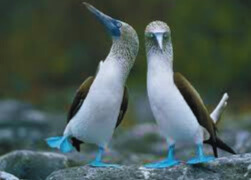
Physical Characteristics & Color
The bird’s most striking feature is its bright blue feet, a result of its diet rich in fresh fish. The intensity of the blue varies with the bird’s health and diet. These seabirds have brown wings and a head with black streaks, contrasting with their white chest and underside. Their long neck and sharp, serrated bill, along with forward-facing eyes, make them adept at plunge-diving.
Lifespan & Reproduction
Blue-Footed Boobies can live up to 17 years in the wild. They start breeding between 1-6 years of age, with males maturing slightly later. Their mating ritual is a spectacle, involving a high-stepping dance by the male to showcase his vibrant feet, a sign of health and vitality. Females lay two to three eggs in nests on rocky coasts, often returning to the same nesting area annually.
Habitat
These birds are found along the Pacific coast from Mexico to Peru and prominently in the Galápagos Islands. They prefer large nesting colonies on rocky coasts near open water. During the day, one parent guards the chicks while the other hunts, and at night, they roost together on the coastline.
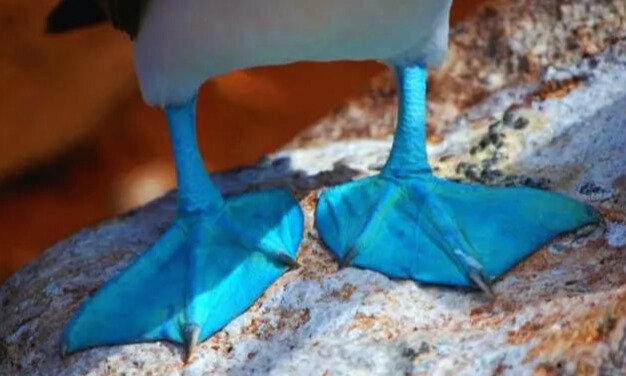
Diet
Their diet mainly consists of fish like anchovies, sardines, and mackerel, and squid. They hunt by plunge-diving from heights, with males and females targeting different prey sizes due to their size variation. The males, being smaller, are shallow divers, while the larger females dive deeper and farther offshore.
Threats & Predators
Human Threats
Blue-Footed Boobies are not naturally afraid of humans, but increased human activity along the Pacific coast poses a threat through hunting and egg theft.
Climate Change
Unusual temperature rises, like during El Niño events, have led to nest abandonment and migration changes, affecting their breeding patterns.
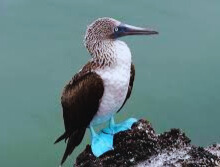
Predators
In the Galápagos, their primary predator is the Galápagos Hawk, which preys on chicks. Food scarcity, particularly a decline in sardine populations, also poses a significant threat.
Conservation Status
The species is currently listed as ‘Least Concern’ on the IUCN Red List. However, there are concerns about decreasing breeding pairs in the Galápagos due to food scarcity.
Fun Facts
- Blue-Footed Boobies dive into the water at speeds up to 67 mph.
- They breathe through the corners of their mouth as their nostrils are permanently closed.
- About 50% of all breeding pairs worldwide are found in the Galápagos Islands.
- Females create nests with guano, which fertilizes the soil post-hatching.
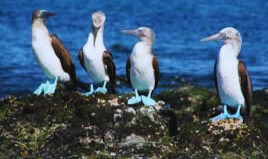
Mating and Nesting Behaviors
The mating and nesting behaviors of the Blue-Footed Booby are particularly intriguing. The male’s dance, a mix of sky-pointing, wing-flapping, and foot-lifting, is not just a display of physical fitness but also a demonstration of his territory. The nests, made on bare ground, are simple yet effective, with the birds using their guano to mark and maintain the nesting site. This behavior ensures a safe and recognizable environment for raising their young.
Adaptations for Survival
The Blue-Footed Booby’s physical adaptations are key to its survival. Their streamlined bodies are perfect for aerodynamic diving, and their large, webbed feet, besides being a mating display, are excellent for powerful swimming. Their eyes, positioned to provide excellent depth perception, are crucial for spotting prey from high altitudes.
Role in the Ecosystem
As predators, Blue-Footed Boobies play a vital role in controlling fish populations, maintaining a balance in the marine ecosystem. Their presence and health are indicators of the overall health of the marine environment, particularly in regions like the Galápagos Islands.
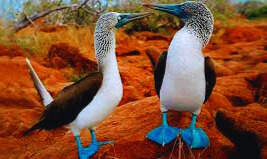
Human Interaction and Ecotourism
While not naturally fearful of humans, increased interaction and habitat encroachment pose risks to these birds. Responsible ecotourism is essential to ensure that their natural behaviors are not disrupted. Observing these birds in their natural habitat can be a mesmerizing experience, but it’s crucial to maintain a respectful distance to avoid any negative impact.
Research and Monitoring
Ongoing research and monitoring of Blue-Footed Booby populations are crucial for understanding their ecological needs and the challenges they face. Studies focusing on their feeding habits, breeding success, and population dynamics provide valuable data for conservation strategies.
Conservation efforts for the Blue-Footed Booby involve habitat protection, pollution control, and addressing the impacts of climate change. Protecting their breeding grounds and ensuring a stable food supply are key to their survival. Conservationists and researchers work together to monitor populations and implement measures to mitigate threats.
The Blue-Footed Booby is more than just a bird with blue feet; it’s a symbol of the rich biodiversity of our oceans. Understanding and protecting this species is not only about preserving a unique creature but also about ensuring the health and sustainability of marine ecosystems where they play an integral role.



